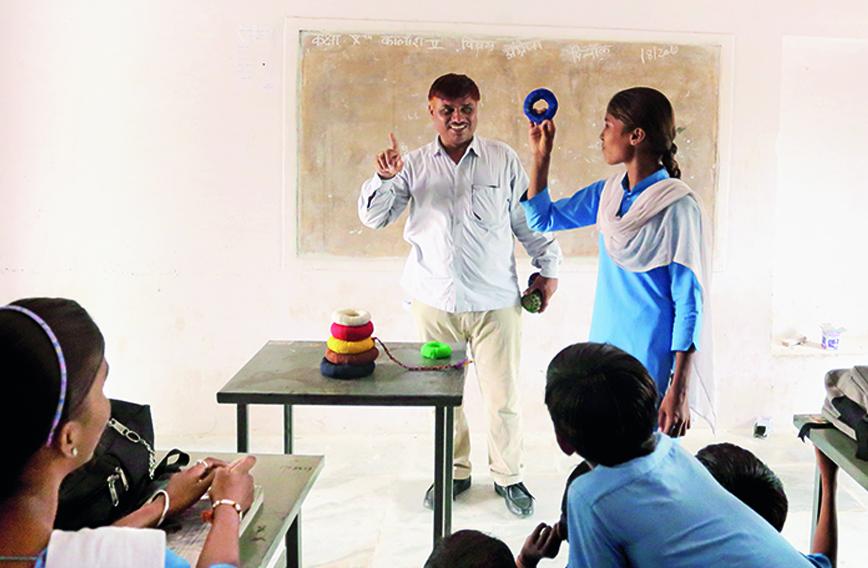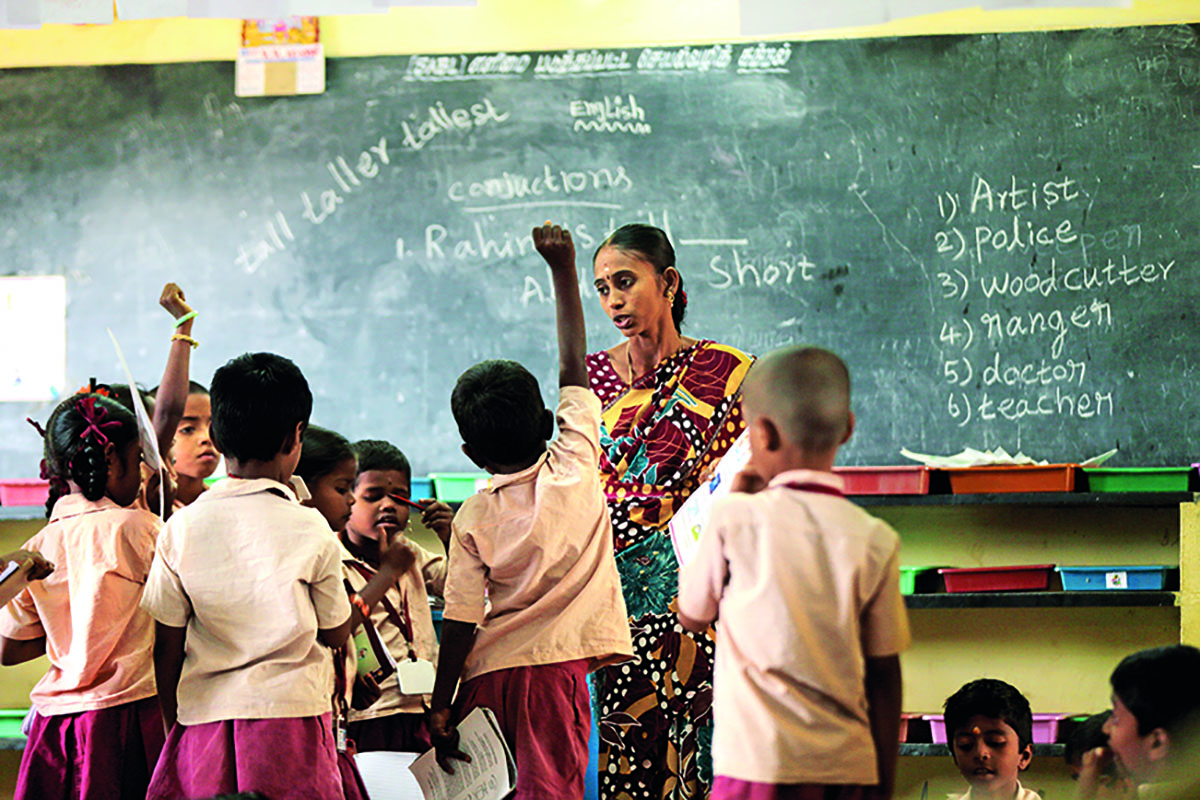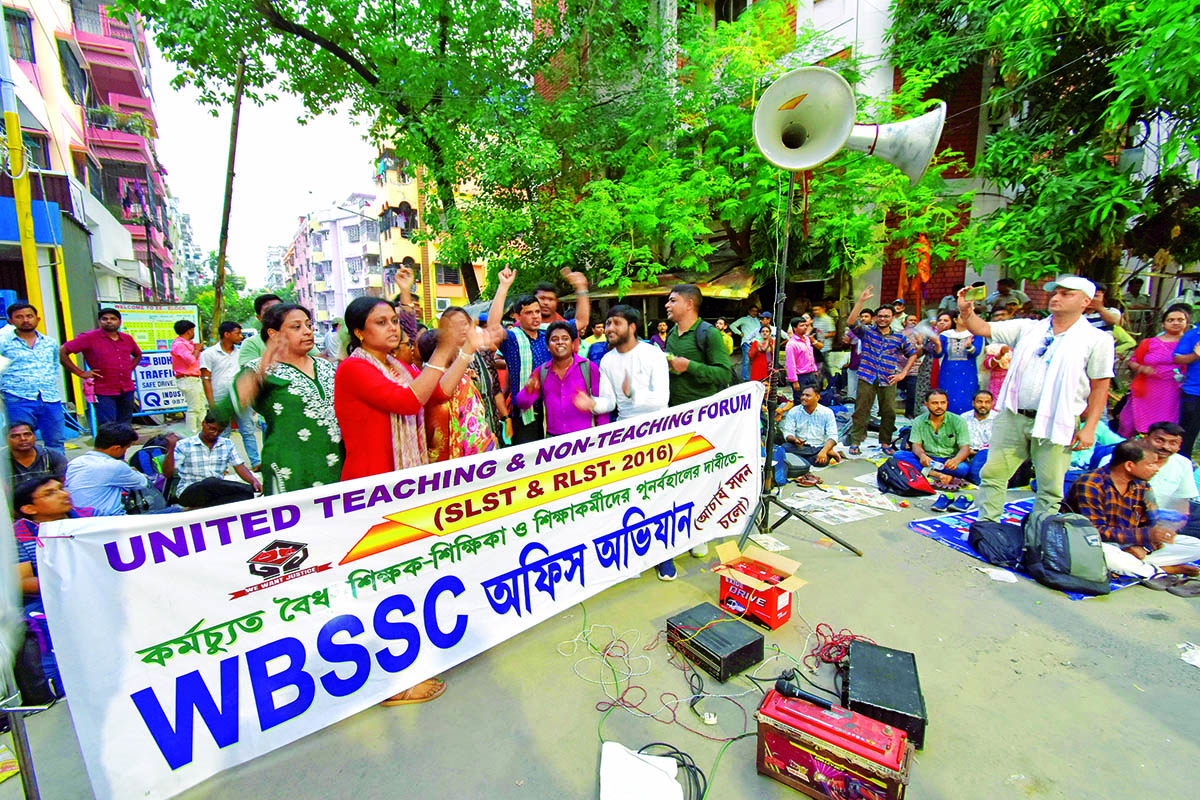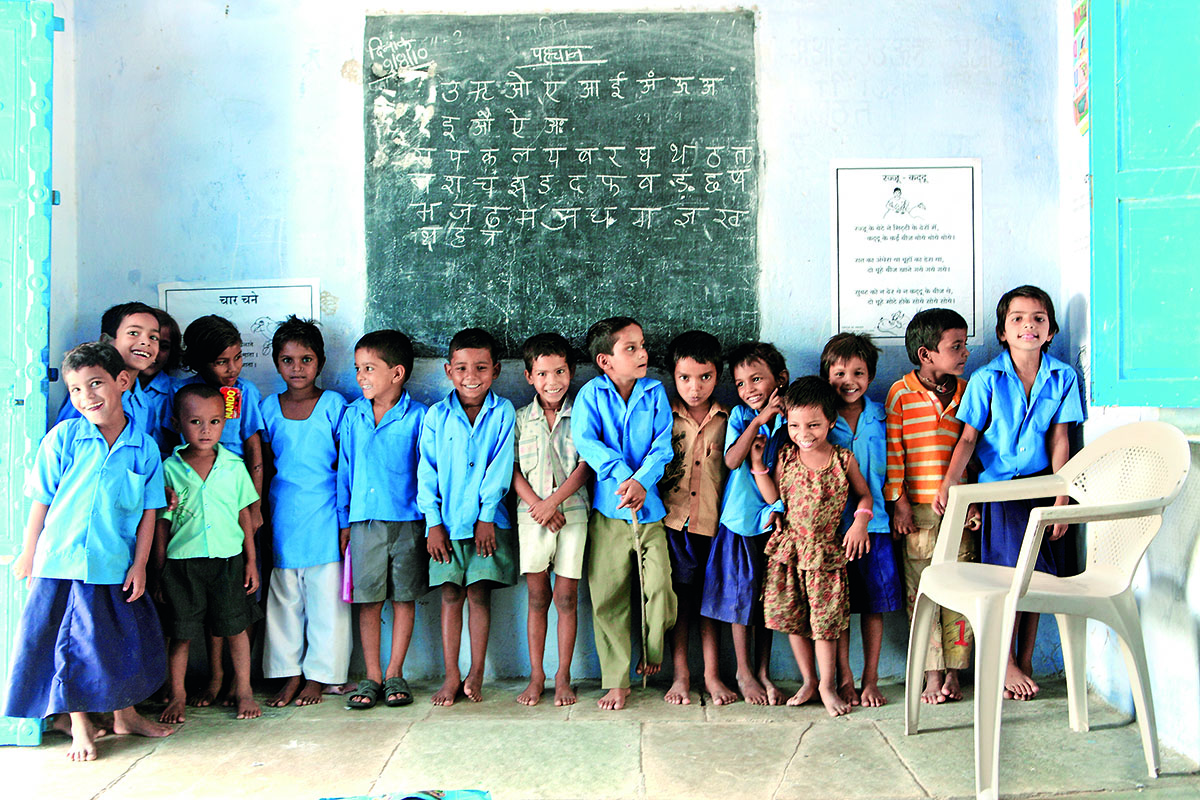
Inspired teachers exist and Ramesh Gharu, in a government school in rural Rajasthan, is one of them
Seeking teachers
Civil Society News, Kolkata / New Delhi
THE Supreme Court recently annulled 25,000 appointments to government-run schools in West Bengal, upholding charges that there had been cheating in a selection examination and that bribes had also been paid for appointments.
Of those whose jobs were gone, 17,000 were teachers who had been in service for 10 years — the time it took for the case to wind its way through the courts. In all, 19,000 schools were impacted as the rusticated teachers went overnight from classrooms to the streets, holding demonstrations and asking to be reinstated.
Faced with the disruption of an academic year, the state government sought relief from the court which allowed some 15,000 teachers to continue working, but only temporarily, till December 31.
Complicating matters was the possibility that a good many of the teachers, according to their assertions, may actually have taken the examination fairly. But the West Bengal School Service Commission apparently no longer has the records to corroborate their documents in court. So, they were all being tarred with the same brush.
How the mess in West Bengal gets sorted out remains to be seen. But the controversy with its many ramifications is an occasion to examine how teachers are being recruited in the country. While well-trained and transparently hired schoolteachers are crucial to the standards of education, the fact is that most states in India lack formal recruitment policies. Teachers have also been getting trained in poorly regulated private institutes. As a result, both teacher training and recruitment remain weak links in the system.
Education is a state subject and state governments are responsible for hiring teachers for schools that are run or aided by them. Generally, their record has been a dismal one. Recruitments have been found to be marred by corruption, politics and favouritism. It is only a couple of states like Karnataka and Tamil Nadu which are cited as exceptions.
Not surprisingly, there have been controversies and court cases. In Haryana, a former chief minister and his family landed in jail on bribery charges over teacher recruitments. West Bengal now joins a list of scandal-hit states such as Haryana, Bihar, Uttar Pradesh and Madhya Pradesh.
In terms of scale, there is no alternative to government schools for meeting the massive and varied demand for education in India. The public school system should be the edifice on which growth and development happen. An affordable, inclusive and accessible education system is needed to bring people up and bridge divides between rich and poor, upper and lower castes. Teachers have to be at the heart of such a system. How teachers are trained, hired, groomed and made effective in classrooms is therefore crucially important.
 In terms of scale there is no substitute for government schools to meet the massive and varied demand for education
In terms of scale there is no substitute for government schools to meet the massive and varied demand for education
In the absence of vision and commitment, investment by the states in education has actually been falling. Without the budgets, fewer teachers are being given regular appointments. Instead there has been a shift to temporary or guest teachers because they cost the state less. Kickbacks and dispensing of favours are also easier with temporary appointments.
PUBLIC VS PRIVATE
As standards have declined in government schools, privately-run ones have mushroomed. They are more expensive and a substantial part of family incomes get spent on fees. But the quality of education is sub-optimal. Private schools have some visibly better infrastructure but the core weaknesses, such as the quality of teachers and pedagogy, are the same. Whether it is government or private schools, these concerns have not been effectively addressed.
It is not as though there are no bright spots. Some of the southern states perform better than the rest of the country. Elsewhere, too, where the overall record may not be great, there are good schools and badly-run ones in both the private and public sectors. With teachers too there are those who make a mark because they are genuinely gifted and diligent. But what is lacking is a system that can provide some uniformity.
The teacher taking a class in our cover picture is a gifted, enthusiastic and successful teacher, Ramesh Gharu. Note the way he holds his students in thrall in a government school in Rajasthan. There are many sides to Ramesh Gharu’s life including the fact that he comes from a low caste and that he grew up cleaning toilets with his father. Education changed everything for him. And now he gives back.
In his brilliant book, Ordinary People, Extraordinary Teachers, S. Giridhar tells the stories of innumerable teachers in the government system who make a difference. But such teachers show up at random and there is no culture in which they can grow and multiply.
CENTRAL EFFORTS
Central legislation and policies have been trying to improve the system. To this end, the Right to Education Act (RTE) was passed in 2009. A new National Education Policy (NEP) was framed in 2020 and again in 2024. The National Curriculum Framework has, in recent times, received more detailed attention than ever before.
These policy measures have led to some upgradation. The National Council for Teacher Education (NCTE) standards regarding qualifications of teachers are being propagated and adopted. Earlier, teachers could be hired by schools after a two-year course. Now, teacher training has to be a four-year course with exposure to multiple subjects. A Teacher Eligibility Test (TET) has been introduced to further vet aspiring teachers. Recruitment examinations have been standardized as objective papers.
But these efforts, too, fall short of delivering a professionalized teaching force that can be effective amid caste, religion, income levels and tribal cultures in the country. There are also the complexities of change in a tech-driven world to be taken into account.
At the broadest level, society hasn’t given education the important status it should have. There is also the lack of political will. While politicians are only too eager to interfere with recruitments to suit their own ends, there is no serious political agenda for improving education. As a result, a lot of the heavy lifting for putting a better system in place remains undone.
“The problem with recruitments is an outcome of the lack of priority given to education in the general agenda. States don’t want to spend the money,” says Dileep Ranjekar, founder CEO of the Azim Premji Foundation.
Ranjekar has spent long years trying to contribute to the improvement of government-led education in India. He believes an overhaul is long due and at the core of such a transformation should be a whole new way of training and hiring teachers. The strictest standards should be applied and only those with the knowledge as well as aptitude should be entrusted with guiding a child’s development.
Systemic change is called for. Four things could be done: One is to overhaul teacher training so as to reduce the burden on recruitment. If the right people are selected for training courses and then trained well, recruitment becomes so much easier. Second is to make the existing recruitment process richer by going beyond subject knowledge to assess softer aspects of a teacher’s role — empathy, sensitivity, pedagogy, etc. If possible, a demonstration class should be included. Third is a strong induction programme for teachers so that they see how some of the better teachers teach. Fourth, there should be a system of review after six months or a year of how the teacher is doing in a classroom.
HUMAN SIDE
Teachers have a special role in classrooms and in society at large as well. They are loved and admired and looked up to as role models. When the recruitment process gets tainted, the image of teachers suffers irreparably. They fall in the eyes of students and the community. Their capacity to hold young children in thrall and pass on learning suffers.
The human side of recruitment scandals such as the one in West Bengal is not properly understood. Not enough attention is paid to the impact on young minds. The lives of the teachers are also upended, beginning with the loss of livelihood.
 Teachers protesting in Kolkata
Teachers protesting in Kolkata
Many of the teachers we spoke to in Kolkata said it was not only the loss of their jobs and incomes, but also their personal credibility. It is devastating to be known as a teacher who cheated in an examination or paid bribes to get a job. What face would they have before students?
They saw in the court’s decision a blow to their reputations. “Yes, this is clearly an attack on our dignity and self-respect,” said Ritesh Ghosh, who teaches Bengali to Classes 11 and 12 at Ranghat Anchal High School in Bagdah block of North 24-Parganas.
The teachers averred that a majority of them had done no wrong. It was the responsibility of the West Bengal School Service Commission to have kept the records and presented them in court.
“Our job was to fill the form, we did that. Our job was to download the admit card, we did that too. Our job was to appear for the exam, and we did that sincerely,” said Debolina Dey, a teacher at Akna Union High School in CD Block of North 24-Parganas. Dey said she supports a family that includes two young children, ageing parents, and her husband.
“Go ask our students if we teach with honesty or not, they’d be the best judges,” said Dey.
HIGHLY POLITICIZED
Not many scholars and researchers have spent time on studying school recruitments. Vimala Ramachandran is one of the few with a granular assessment of what has been happening. She has been a professor of teacher management and development, and has done extensive research on the subject.
“Poor recruitment policies and practices make schoolteaching a second-class profession,” says Ramachandran. “The recruitment of schoolteachers across the country has remained highly politicized for several decades.”
“In a nationwide study that I was part of we found that most states in India do not have a clear and transparent teacher recruitment policy. Recruitments are done through government orders — and every time recruitments are made, a fresh government order is issued,” she says.
Ramachandran explains that the uncertainty over recruitments — how and when they would happen — has implications for the quality of the teaching force.
Other issues are transparency and school-specific needs. There is a “huge mismatch” between the requirements of the schools for subject-wise / grade-specific teachers and the “supply” as reflected in transfers and postings.
“This uncertainty gives teaching a non-serious reputation, discourages applicants from investing systematically in building pre-service teaching skills, and attracts applicants with little interest in teaching,” she says.
Most states are yet to formalize a teacher recruitment policy. There are huge variations across states. There are states that have adhered to similar processes and norms year after year. Others look at each cycle of recruitment as a fresh exercise and each time announce the procedures for recruitment. This is where the irregularities often creep in.
It is possible for states to pull together a better performance in teacher recruitment. In Karnataka and Tamil Nadu eligibility tests are followed by counselling. Teachers are appointed to a specific school on the basis of the requirement of the school. The process in these two states has been found to be both transparent and smooth.
WORKFORCE STUDY
A 2018 teacher workforce study revealed that heads of schools were rarely consulted when district-wise vacancy lists were prepared. Nor did such lists take into account the subjects in which there were severe teacher shortages.
In the absence of a formal policy and a recruitment system, many states have not been able to provide the required three subject teachers in more than one-fifth of their upper primary schools. The worst scenario in this respect is seen in Uttar Pradesh where 90 percent of upper primary schools are without all three subject teachers followed by Maharashtra (80 percent), Jammu and Kashmir (70 percent), Madhya Pradesh (69 percent), Jharkhand (57 percent), Rajasthan (53 percent) and Uttarakhand (42 percent).
“The problem is severe in secondary schools. Only 3.3 percent of government secondary schools meet the norm of five teachers (two language teachers, and one teacher each for mathematics, social science and science) and a head teacher. More than 14 percent of secondary schools have only one or two teachers — the situation in UP (over 30 percent), and Jharkhand and Rajasthan (both over 20 percent) is particularly bad,” Ramachandran says.
TEACHER ELIGIBILITY
The teacher is injected into this muddled situation. The quality of education imparted in the classroom finally depends on the teacher. The quality of the teacher in turn depends on teacher education institutions. The quality of the education institutions depends on the rigour of the oversight they are subjected to and the quality of faculty in such institutions.
As it transpires, for the longest time a significant number of private institutes for educating teachers have mostly been dispensing certificates for a price. Even attendance is not mandatory. The course would be for two years and straight after Class 12. Several generations of teachers have been spewed by these institutes and continue to populate the school ecosystem at various levels.
When the Teacher Eligibility Test (TET) was introduced in 2009, with the RTE becoming a law, the teacher education system was shown up for what it had become. Barely two percent of qualified teachers could pass the test in the early years. Now the number of those who get
through has increased somewhat.
But TET only serves as a barrier. If anything, it shows that teacher education has largely been flawed. Despite TET having thrown into relief the gross inadequacy of teacher education, no concrete actions have been taken to fix that. Further, there is no standardization of TET across the nation.
“The eligibility tests were introduced to mitigate the negative impact of people with bogus degrees entering the teacher workforce,” says Ramachandran. But by that time several years had been lost and the system had been vitiated. Once again, in better managed states such as Tamil Nadu and Karnataka an eligibility test existed from much before.
With policymakers and administrators looking on, training teachers seems to have been a profitable business even as educational standards have foundered. We learn from Ramachandran’s research that in 1951 there were only 128 teacher education institutions — 104 in the private sector and 24 in the government sector. In 1991 this went up to 872 — with 738 in the private sector and 134 in the government sector. The exponential increase happened in the decade of the 2000s — in 2001 there were 1,084 institutions (936 private and 148 government) and in 2008 this sharply increased to 4,720 (4,500 private and 220 government) and in 2013 there were 6,848 institutions (6,622 private and 226 government).
TET is held at state and national level. Similarly, recruitment tests are now centrallized. The questions are objective and designed to determine subject knowledge. Centrallized examinations have been the subject of some debate, especially so when charges of cheating and manipulation arise. But they are widely recognized as at least keeping out candidates who don’t have the basic knowledge of their subjects.
It is, however, not enough. Ranjekar argues that teacher assessment should seriously begin with teacher education and therefore from much before the recruitment stage. He also suggests having a layer of competent people who know to handle recruitment “objectively
and in a non-corrupt way”.
“The standard of teacher education and the eligibility bar should be made so high that it is difficult to become a teacher. This is what it is in Finland, Sweden and other countries which have a good quality of education. An elaborate recruitment process then becomes redundant,” he says.
 There is a huge unfulfilled demand for teachers in government schools
There is a huge unfulfilled demand for teachers in government schools
“The role of the teacher goes much beyond subject knowledge. The teacher is at the heart of education. Teachers ideally have to be recruited in the most careful manner. Of course, subject knowledge is important,” elaborates Ranjekar. “But a teacher has also to be chosen for aptitude, philosophy about child development, about the kind of role education plays in society and therefore the kind of contribution we have to make to the child. The child has to be at the centre of the education process. Remember, the child is not an inanimate object and is able to contribute to his or her own development and the teacher has to recognize this.”
Ranjekar believes that with a little effort it is possible to have a practical demonstration and an interview in addition to the written test. It is here that another layer of competent people is needed to make the recruitment process more meaningful.
EXAM FILTERS OUT
Indu Prasad, Vice Chancellor of the Azim Premji University, believes that centrallized objective test papers have been successful in keeping out candidates who just don’t measure up. Interviews and demonstration classes have their value but when hundreds of thousands of people have to be assessed, an objective examination is indispensable in her view. It is also free from bias and grey areas, reducing the chances of an examination and appointments being thrown into dispute.
“What we are grappling with are numbers and scale. On the other hand, if evaluations for appointments are handled at the level of the district or the school complex instead of the state, as the NEP envisages then the numbers would, perhaps, be handleable. But anything like this would require a massive systemic change which I don’t see happening in the near future,” she says.
Testing is enough of a science, explains Prasad, to make it possible to use well-framed subject-related questions to test knowledge, ability, personality, and aptitude.
“Directly asking questions on attitude is not very useful because everyone knows the kind of politically correct answer to give. But if you design a question on teaching a particular concept to a particular set of children, you can actually learn a lot about the attitude or teaching ability of a candidate,” she says.
GRADED PRACTICE
But recruitment tests, agrees Prasad, should be preceded by sound teacher preparation. Four-year teacher preparation programmes are critical for this because of the time and opportunities for learning that they provide.
“Working from before that test is critical. It just won't work if you just change the test. That's what happened to us when we first introduced the teacher eligibility test. Less than five percent cleared it,” she says.
“The teacher preparation programme has got to have feet absolutely on the ground, which is why there should be a continuous connection with school and the idea of what we call graded practice. To start with, you just spend time in a school, watch and observe everything going on. Around the beginning of the third year, you start doing small things and in the fourth year you spend six months as a member of the school, teaching and doing other things as well, all under supervision,” she says, emphasizing the practical side of teaching.
She speaks from her own experience of her first few years as a teacher: “Plenty of practice. Spend lots of time in school. Come back, talk to folks, figure out your ideas. Learn from the teachers in that school. Learn what to do. Learn what not to do. Learn everything.”
“What helps in those first two or three years is to have a senior teacher you can talk to, bounce ideas off,” she says.
India’s education landscape is vast and variegated. It calls for local and regional initiatives. At the same time, national frameworks and a collective sense of purpose are required. It is a tightrope to walk. Both passion and skill have to be employed. Political will and sense of mission are called for.
Under the Samagra Shiksha scheme the Union government seeks to provide direction to school education from the pre-primary level upwards. It supports the RTE. It also covers teacher education. But is this another example of falling prey to labels and wanting to be seen as doing things instead of facilitating a spirit of getting things done?
The education system has been short on action even as policy has been heading in the right directions. An example is NEP’s current emphasis on play schools and pre-primary learning. There aren’t the teachers nor is there the infrastructure to implement it. The Anganwadi system which was conceived of 30 years ago is in complete disrepair.
There was a time when government schools and suburban colleges delivered a good education. Many universities had an identity and a presence of their own. There are any number of examples of people who got an education in these institutions doing well for themselves later on. You will hear talk of famous people who came out of obscure institutions.
Political will is now needed to reverse the neglect over the years and to energize the system so that it is more even in quality and broadbased. Stewardship is required. Clear goals have to be set, chief among them being radical reforms in teacher education and investments in government institutions. ν
With reporting by Aiema Tauheed from Kolkata
Comments
Currently there are no Comments. Be first to write a comment!





